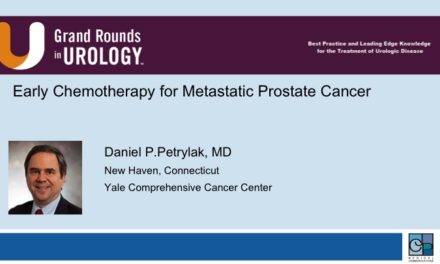Dr. Daniel P. Petrylak spoke at the 24th International Prostate Cancer Update on Saturday, February 22, 2014 on “The Latest on Chemotherapeutic Approaches.” In his presentation, Dr. Petrylak discusses the latest chemotherapeutic approaches for prostate cancer and what the future holds.
Presentation:
Keywords: chemotherapeutic approaches, docetaxel, cabazitaxel, clusterin, prednisone, castrate-resistant prostate cancer
How to cite: Petrylak, Daniel P. “The Latest on Chemotherapeutic Approaches.” Grand Rounds in Urology. January 14, 2015. Accessed Dec 2024. https://dev.grandroundsinurology.com/prostate-cancer-daniel-p-petrylak-chemotherapeutic-approaches/.
Transcript
The Latest on Chemotherapeutic Approaches
CD40504, dasatinib, those showed no improvement survival. Same thing with lenalidomide and the only trial that’s out there that may show an advantage is the clusterin trial, and we’ll go into detail about that a little bit later.
More than 20 should have hit by statistics. Unfortunately, none of these showed an improvement in survival and we have to really think about this in terms of the biology, as well as why these trials failed. And also the decision going from phase one or phase two to phase three, and if you look at the data, it’s all varied across the board as far as how much preclinical and clinical work was done prior to these agents going into clinical trials.
So this is one of the more recent clinical trials that’s been presented. This was presented at ESMO in 2012. It’s actually being submitted to the Journal Of Clinical Oncology. This is our study looking at lenalidomide combined with docetaxel and prednisone and comparing the placebo with docetaxel and prednisone.
Lenalidomide, as you know, is a thalidomide derivative. It also has immunomodulatory characteristics and, as a single agent also in phase one data and phase two data from our institution, it showed responses in patients who were docetaxel refractory. So combining lenalidomide with docetaxel showed further responses in patients who were progressing.
So based upon these observations, we went into the phase three study and this was an international effort. Patients were randomized on a one-to-one basis and, unfortunately, we found that the experimental arm had a trend toward an overall worse survival than the docetaxel/prednisone arm. And there are a number of reasons that we least think may be related to this and one of which is related to the number of cycles of docetaxel administered.
As we see in lenalidomide/docetaxel/prednisone arm, a mean of six were administered, and in the control arm, it was eight. And predominantly, patients came off due to toxicity. So we all know docetaxel is a good drug and, in fact, some marginal drugs that are added may actually impede upon the responses that are seen in these particular patients. So the dose reduction is something that we think may be related to the overall lack of efficacy in that trial.
Another example as to why some of these trials didn’t work comes from SWOG 0421. It’s the randomized trial comparing atrasentan combined with docetaxel to docetaxel alone. And this is about as close a survival curve as you can get. They’re almost superimposable. The median survival was what you would see in the TAX 327 trial of 18 months.
So why did this trial fail? Certainly you think that a bone-targeted agent may actually have a significant amount of activity in combination. Well, if you look at some bone markers that had been previously shown to be prognostic in castrate-resistant prostate cancer such as anti-lipopeptide and alkaline phosphatase, you see that those particular patients who have the highest bone marker levels and those patients who receive the atrasentan, the bone targeted agent along with the docetaxel, actually had an improvement in survival in subgroup analyses.
So we were not selecting our patients properly. We were only taking patients who were all comers for these trials and it may be by stratifying patients more rationally that some of these drugs that have marginal activity, may have some more activity. But I think that it’s important that we learn from these particular studies as to better designing phase three trials in the future.
So this is the only agent that is still now out there in combination with docetaxel. It’s also being looked at in combination with cabazitaxel. This is targeting a protein called “clusterin.” Clusterin is expressed in human cancers. In fact, kidney, bladder, and prostate cancers all make clusterin. This is a stress protein that’s up regulated after drug exposure. Also it increases after radiation therapy and it is correlated with grade endstage and prostate cancer. So one logical approach would be knock down clusterin to increase the chemosensitivity of cells.
In a sense, therapy has been very, very controversial over the years and a lot of oncologists meet it with a great deal of skepticism. For a long time, it was thought that the antisense compounds which target — did not penetrate into the tissue. And Marty Gleave has actually modified the backbone of the antisense to make it more tissue permeable and he actually did a proof-of-concept trial where he administered this to radical prostatectomy patients and looked at clusterin levels post treatment.
As you can see on the upper left portion, there is a dose-dependent effect with clusterin. The antisense will increase the apoptotic index as we see on the bottom right and if you start looking at overall protein levels of clusterin, they decrease. So this I think was good enough evidence to show that the drug hit the target and also affected the target as well.
So of course we go into the randomized phase two trial in prostate cancer and again be aware of the randomized phase two because they still can’t have a significant amount of heterogeneity. And this is one of the disconnect patterns we’ve seen with randomized trials.
So on the left side is the time to progression, which is not significant when patients receive docetaxel plus the clusterin antisense versus docetaxel alone. On the right side, we see a survival advantage in favor of the combination. So it’s the same pattern we’ve seen with Provenge, where there’s a disconnect between progression-free survival and overall survival.
And there was a lot of back and forth that went on during this time as to whether this was a real effect or not, but of course the only way to prove this is to do a full-fledged randomize phase three. And this is combining clusterin with docetaxel or –, which is the antisense, combine with prednisone to docetaxel alone. The trial has met its approval goal. It’s now in the observation stage and I hope that we’ll have an answer to this for this year since the Synergy trial and I hope that we will be able to report some data to you next year about this.
So what about other chemotherapeutic agents. Cabazitaxel is also approved for castrate-resistant prostate cancer. It has the same potency in the laboratory in docetaxel sensitive lines, but the interesting thing is in the resistant lines that have been raised against docetaxel, it also has activity. And this was found through a drug screen and it’s, as I mentioned before, active in docetaxel-resistant tumor cell lines.
This trial actually took a lot of us by surprise. One would not expect that a similar drug would show survival benefit in castrate-resistant prostate cancer, but this is the tropic study. It was the international trial led by Oliver Sartor and Johann de Bono, and it compared mitoxantrone and prednisone to cabazitaxel and prednisone in those patients who had previously been treated with docetaxel.
We often think of this as a second-line study, but about a quarter of patients had two or more prior chemotherapies. So, in fact, this is a fairly heavily pretreated group of patients. And as we see from the intent-to-treat survival analysis about a three-month improvement in the median survival in favor of cabazitaxel and prednisone over mitoxantrone and prednisone.
The problem with this drug is that it does cause significant neutropenia and the toxic deaths that occurred on the cabazitaxel arm all were related to neutropenic fevers. So that has led on the label to add prophylactic growth factors to cabazitaxel and also in patients who may think that they are at risk for neutropenia, it’s not unreasonable to consider starting them at 20 mg/m2 and then escalating to 25 if they tolerate it on the first cycle. So febrile neutropenia was the major problem, as well as diarrhea, and again that can be treated with loperamide or other agents.
So where is this moving forward at this particular time? Well there are two randomized trials that are again completed to accrual that hopefully will read out within the next couple of years. The first — trial is comparing front-line docetaxel to front-line cabazitaxel, either 20 or 25 mg/m2, and this is looking at whether cabazitaxel is a superior survival to docetaxel. I think it’s going to be fairly difficult to see this because of all the other secondary agents, number one.
But number two, there is a crossover arm to this. So patients who go on doce can go on cabazi and vice a versa. And I think that that’s going to cause some difficulty in interpreting the study. The PROSELICA trial is being run by Mario Eisenberger and that’s a very simple randomized trial looking at cabazitaxel 25 versus 20 to see if there’s any difference in survival between the two different arms.
As we mentioned before, there is a second trial called “Affinity” that is combining cabazitaxel with the clusterin antisense and comparing that to cabazitaxel and prednisone alone, and that trial is now actively accruing across the United States.
Well I think we’ve raised some other questions during this meeting about taxanes and how to sequence them with drugs such as abiraterone. And I think the important factor that has been noted is that taxanes may also be antiandrogens. If you look at nuclear localization of antitubulin or the androgen receptor after the administration of antitubulin agents, you’ll find that antitubulin agents will prevent translocation of the androgen receptor across the nucleus.
You can see this in circulating tumor cells from patients who were treated with docetaxel. In fact, those cells that do not translocate are those that are sensitive in the patients responding. Those that do translocate are resistant.
So docetaxel may be an antiandrogen and, in fact, if you start looking at patients treated sequentially with abiraterone, then they receive docetaxel after that. This is a very small — of patients. We see a lower overall PSA response rate. It’s about 30% and the survival is about 13 months compared to the 18 months that you see with docetaxel in the TAX 327 trial. And same thing with time to progression. It’s also somewhat shorter.
Generally, if patients don’t respond to abiraterone, they won’t respond to docetaxel at least from this particular data set. But again, I caution you. This needs perspective evaluation to determine whether that’s a real observation or not.
So I think in the future, we’ve got to start looking at mechanisms of resistance as to why patients fail docetaxel and we actually published some data about two years ago looking at the characteristics of the resistant cell in a tissue culture and found that there’s actually an up-regulation of stem cell markers and such as –, and also that you can identify these particular cells in human tumor specimens. And in fact, what I think is very, very interesting about this particular cell is that it does not express the androgen receptor.
So this is something that we may be considering to target in the future for docetaxel resistant cells. In fact, when you look at Ken Pienta’s autopsy data, the same pattern of stem cell markers is present in the autopsy specimens and this may be the terminal event in castrate-resistant prostate cancer, which we may need to begin to target.
So I think that’s where the future’s going to lie with cytotoxic therapy. But unfortunately further manipulation of based-based chemotherapy is unlikely to provide therapeutic improvements. It is still the front-line standard of care for chemotherapy for castrate-resistant prostate cancer and markers of resistance are now being identified that potentially can help improve treatment.
So I’ll stop there and invite my colleague…actually, do we have the ARS questions? So let’s get our ARS questions up. So cabazitaxel is as effective as based as a first-line chemotherapeutic agent. Should be used with prophylactic growth factors support as second-line therapy, has a one-month improvement in survival, and compared to mitoxantrone and prednisone, is approved by the FDA as first-line cytotoxic therapy.
So the answer is two. It should be used with prophylactic growth factor support. There is no evidence for using it as front-line therapy at this time. If that trial is positive, that will change.
Last question. Which of the following agents has demonstrated survival benefit in combination studies with based in men with castrate-resistant prostate cancer? atrasentan, –, cabazitaxel, OGX 427, or none of the above. The answer is none of the above.
None of these agents have shown a survival benefit and that’s where our future lies.
References
Chi KN, Siu LL, Hirte H, et al. A phase I study of OGX-011, a 2′-methoxyethyl phosphorothioate antisense to clusterin, in combination with docetaxel in patients with advanced cancer. Clin Cancer Res. 2008 Feb 1;14(3):833-9. http://www.ncbi.nlm.nih.gov/pubmed/18245546
Chi KN, Hotte SJ, Yu EY, et al.
Randomized phase II study of docetaxel and prednisone with or without OGX-011 in patients with metastatic castration-resistant prostate cancer. J Clin Oncol. 2010 Sep 20;28(27):4247-54. http://www.ncbi.nlm.nih.gov/pubmed/20733135
Cook RJ, Coleman R, Brown J, et al. Markers of bone metabolism and survival in men with hormone-refractory metastatic prostate cancer. Clin Cancer Res. 2006 Jun 1;12(11 Pt 1):3361-7. http://www.ncbi.nlm.nih.gov/pubmed/16740758
Lipton A, Cook R, Saad F, et al. Normalization of bone markers is associated with improved survival in patients with bone metastases from solid tumors and elevated bone resorption receiving zoledronic acid. Cancer. 2008 Jul 1;113(1):193-201. http://www.ncbi.nlm.nih.gov/pubmed/18459173
Mezynski J, Pezaro C, Bianchini D, et al. Antitumour activity of docetaxel following treatment with the CYP17A1 inhibitor abiraterone: clinical evidence for cross-resistance? Ann Oncol. 2012 Nov;23(11):2943-7. http://www.ncbi.nlm.nih.gov/pubmed/22771826
Miyake H, Pollak M, Gleave ME.Castration-induced up-regulation of insulin-like growth factor binding protein-5 potentiates insulin-like growth factor-I activity and accelerates progression to androgen independence in prostate cancer models. Cancer Res. 2000 Jun 1;60(11):3058-64. http://www.ncbi.nlm.nih.gov/pubmed/10850457
Miyake H, Chi KN, Gleave ME.Antisense TRPM-2 oligodeoxynucleotides chemosensitize human androgen-independent PC-3 prostate cancer cells both in vitro and in vivo. Clin Cancer Res. 2000 May;6(5):1655-63. http://www.ncbi.nlm.nih.gov/pubmed/10815883
Parczyk K, Pilarsky C, Rachel U, et al. Gp80 (clusterin; TRPM-2) mRNA level is enhanced in human renal clear cell carcinomas. J Cancer Res Clin Oncol. 1994;120(3):186-8. http://www.ncbi.nlm.nih.gov/pubmed/8263017
Petrylak DP, Tangen CM, Hussain MH, et al. Docetaxel and estramustine compared with mitoxantrone and prednisone for advanced refractory prostate cancer. N Engl J Med. 2004 Oct 7;351(15):1513-20. http://www.ncbi.nlm.nih.gov/pubmed/15470214
Redondo M, Villar E, Torres-Muñoz J, et al. Overexpression of clusterin in human breast carcinoma. Am J Pathol. 2000 Aug;157(2):393-9. http://www.ncbi.nlm.nih.gov/pubmed/10934144
Steinberg J, Oyasu R, Lang S, et al. Intracellular levels of SGP-2 (Clusterin) correlate with tumor grade in prostate cancer. Clin Cancer Res. 1997 Oct;3(10):1707-11. http://www.ncbi.nlm.nih.gov/pubmed/9815554
Miyake H, Hara I, Hara S, et al. Synergistic chemosensitization and inhibition of tumor growth and metastasis by adenovirus-mediated P53 gene transfer in human bladder cancer model. Urology. 2000 Aug 1;56(2):332-6. http://www.ncbi.nlm.nih.gov/pubmed/10925118
Tannock IF, de Wit R, Berry WR, et al. Docetaxel plus prednisone or mitoxantrone plus prednisone for advanced prostate cancer. N Engl J Med. 2004 Oct 7;351(15):1502-12. http://www.ncbi.nlm.nih.gov/pubmed/15470213
Zellweger T, Chi K, Miyake H, et al. Enhanced radiation sensitivity in prostate cancer by inhibition of the cell survival protein clusterin. Clin Cancer Res. 2002 Oct;8(10):3276-84. http://www.ncbi.nlm.nih.gov/pubmed/12374699
Zhu ML, Horbinski CM, Garzotto M, et al. Tubulin-targeting chemotherapy impairs androgen receptor activity in prostate cancer. Cancer Res. 2010 Oct 15;70(20):7992-8002. http://www.ncbi.nlm.nih.gov/pubmed/20807808
Q&A
1. Cabazitaxel is effective as a base as a first-line chemotherapeutic agent; should be used with prophylactic growth factors support as second-line therapy; has a one-month improvement in survival; or compared to mitoxantrone and prednisone, is approved by the FDA as first-line cytotoxic therapy?
The answer is two, it should be used with prophylactic growth factor support. There is no evidence for using it as front-line therapy at this time. If that trial is positive, that will change.
2. Which of the following agents has demonstrated survival benefit in combination studies with based in men with castrate-resistant prostate cancer: atrasentan; cabazitaxel; OGX 427; or none of the above.
The answer is none of the above. None of these agents have shown a survival benefit and that’s where our future lies.
ABOUT THE AUTHOR
Daniel P. Petrylak, MD, is currently Director of Genitourinary Oncology, Professor of Medicine and Urology, Co-Leader of Cancer Signaling Networks, and Co-Director of the Signal Transduction Program at Yale University Cancer Center in New Haven, Connecticut. He is a recognized international leader in the urology field. He earned his MD at Case Western Reserve University School of Medicine in Cleveland Ohio. He then went on to complete his Internal Medicine Residency at Albert Einstein College of Medicine/Jacobi Medical Center in the Bronx, and his fellowship at Memorial Sloan Kettering Cancer Center in New York.
Dr. Petrylak has served as principal investigator (PI) or co-PI on several SWOG clinical trials for genitourinary cancers. Most notably, he served as the PI for a randomized trial that led to the FDA approval of docetaxel in hormone refractory prostate cancer. He also helped to design and served as PI for the SPARC trial, an international registration trial evaluating satraplatin as a second-line therapy for hormone refractory prostate cancer.
Dr. Petrylak served on the program committees for the annual meetings of the American Urological Association from 2003-2011, and for the American Society of Clinical Oncology from 1995-1997 and 2001-2003. He also has served as a committee member for the Devices and Immunologicals section of the FDA. He has published extensively in the New England Journal of Medicine, Journal of Clinical Oncology, Journal of the National Cancer Institute, Cancer Research, and Clinical Cancer Research.





